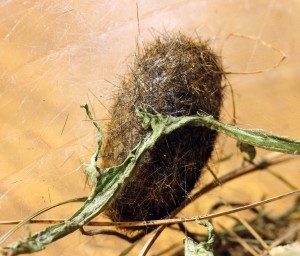The kids are learning about caterpillars in preschool tomorrow. The wooly bear is a caterpillar or larva.
 Observing The Woolly Bear Mynature Apps
Observing The Woolly Bear Mynature Apps
In the spring when temperatures begin to reach 15o C feed your caterpillar fresh leaves when it becomes active.

How to raise a wooly bear caterpillar. Fortunately entomologists were also curious if this little fluffy caterpillar could be a seer of winters fate. Now she is making a chrysalis will turn into a moth. They leave their plants as third instar larvae then look for a cool dark place usually underneath leaf detritus to.
Keeping this in consideration how do you take care of a wooly bear caterpillar. In response to the many questions received on how to look after caterpillars here are 10 easy steps to follow. Since woolly bear caterpillars need to be in the cold to survive keep the container somewhere outdoors.
You can then carry the caterpillar. They are safe to handle and observe close up. The woolly bear is actually the freeze-tolerant final instar caterpillar of the common tiger moth Pyrrharctia isabella.
Then give the caterpillar a little nudge on the behind. The best way to pick up and transport a caterpillar is to take a sheet of paper or a leaf and place it in front of the caterpillar. Wooly bears can be taken in and raised as an insect pet over several months as they complete their life cycle.
Each day use a spray bottle to mist the bottom of the container. Woolly bear or wooly bear Caterpillar of a tiger moth. I put him into a mason jar with grass leaves and a stick and of course holes in the lid.
And after several rigorous scientific studies where they measured the width of the orange band on the caterpillars middle and then compared that to the ensuing winter records it was discovered the colors on the caterpillar have no bearing at all on forecasting weather. The caterpillar will then walk forwards onto the leaf or paper in order to avoid your touch. Since it is April do I still get soil for the jar and put him in the garage.
For example some caterpillars survive winter by burrowing under leaf litter or squeezing into bark crevices while others pupate as cooler weather approaches and remain in this state until spring. The key to caring for a caterpillar at any time of year is to provide conditions that mimic the caterpillars natural cycle and habitat through seasonal changes. However misting the environment is important.
In other words the woolly bear. When the weather turns colder place dead leaves on the bottom of the container for the caterpillar to sleep under. It combats cold temperatures by producing a sort of antifreeze as temperatures cool.
As highlighted in the introduction to rearing butterfly and moth caterpillars anyone regardless of age and experience can learn how to rear these magnificent insects. My Woolly Bear made its cocoon. Wooly bear caterpillar - YouTube.
It really is possible to witness one of the wonders of the natural world taking place in your own front room. A small tank with a lid or a Tupperware or recycled cottage cheese container with a few small air holes in the top is all that is needed. Mist the cage regularly.
My 4 year old son found a wooly bear caterpillar this weekend. Fed her kept herhim warm. A paper towel in the bottom makes clean-ups easier.
The width of the black bands is purported to predict the severity of the coming winter. The Isabella Tiger Moth caterpillar is called the generic Wooly Bear the Black-ended Bear and the Banded Wooly Bear. A woolly bear caterpillar needs the cold temperatures to get ready for hibernation.
Wolly Bear Catepillars - How to care for them - Woolly Bear Isabella Tiger Moth. Weve had her for a few weeks. The larva of the Isabella tiger moth Isia isabella known as the banded woolly bear is brown in the middle and black at both ends.
The caterpillar likely would have died if it. Small droplets of water can help a Wooly Bear Caterpillar stay hydrated. Theyre not as distinctive in their early stages.
You did exactly the right thing under the circumstances. Check your Bear often and mist with water if it looks dry. These nondestructive caterpillars feed on corn asters birches and sunflowers among other things.
Wolly Bear Catepillars - How to care for them - Woolly Bear Isabella Tiger Moth - YouTube. Found this wooly bear caterpillar took it in from the cold. To feed your caterpillar put plants leaves flowers and grasses from the area where you found it into the containerAlso mist the inside of the container with water every day so your caterpillar stays hydrated.
Wooly Bear Caterpillars do not need a water container and it can actually be a drowning hazard. A mature female Isabella Tiger Moth calls to males by emitting pheromones chemical signals at night and males use their sensory antennae to zero in on her.